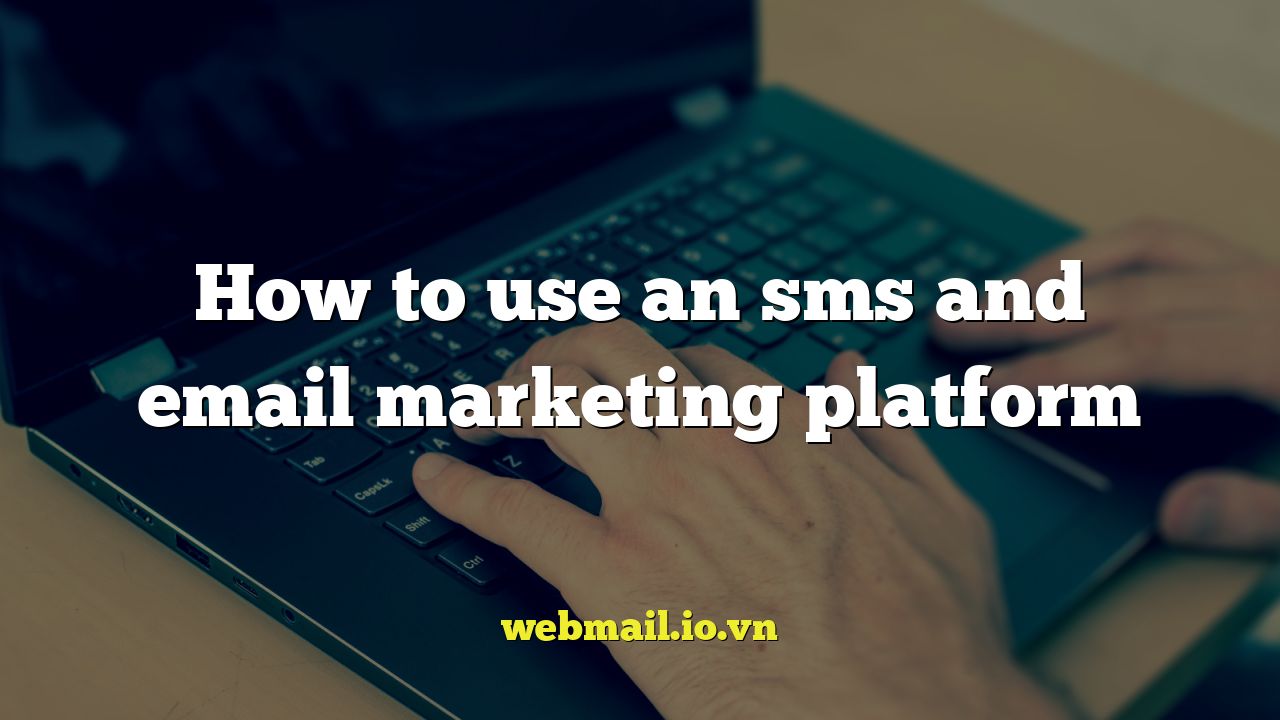
Introduction to SMS and Email Marketing Platforms
In today’s digital landscape, effective communication is crucial for business success. SMS and email marketing platforms offer powerful tools to connect with your audience, promote your brand, and drive sales. These platforms streamline the process of creating, sending, and tracking marketing messages, allowing you to reach customers directly on their mobile devices and inboxes. This article will guide you through the essential steps of using an SMS and email marketing platform to maximize your marketing efforts.
Choosing the Right Platform
Selecting the right platform is the first crucial step. Numerous options exist, each with its own features, pricing, and integrations. Consider your business needs, budget, and technical expertise when making your decision. Some popular platforms include Mailchimp, Klaviyo, Sendinblue, Twilio, and ActiveCampaign. Research and compare their offerings to find the best fit for your specific requirements.
Key Factors to Consider:
- Pricing Structure: Understand the different pricing tiers and whether they align with your budget and contact list size.
- Features: Evaluate the available features, such as automation, segmentation, A/B testing, and reporting.
- Integrations: Ensure the platform integrates seamlessly with your existing CRM, e-commerce platform, and other marketing tools.
Setting Up Your Account
Once you’ve chosen a platform, the next step is setting up your account. This typically involves providing basic information about your business, verifying your email address, and configuring your sender settings. You’ll also need to comply with relevant regulations, such as GDPR and TCPA, by obtaining consent from your contacts before sending them marketing messages.
Account Setup Checklist:
- Provide accurate business information.
- Verify your email address and phone number.
- Set up sender authentication (SPF, DKIM, DMARC) for email.
- Obtain necessary consent from your contacts.
Building Your Contact List
A high-quality contact list is essential for successful SMS and email marketing. Focus on building an organic list of subscribers who have explicitly opted in to receive your messages. Avoid purchasing or scraping lists, as this can damage your sender reputation and lead to poor engagement rates. Offer incentives, such as discounts or exclusive content, to encourage people to subscribe.
Strategies for Growing Your List:
- Use opt-in forms on your website and social media channels.
- Offer lead magnets in exchange for email addresses.
- Run contests and giveaways.
- Promote your email and SMS lists in your marketing materials.
Creating Engaging Content
The content of your SMS and email messages is critical for capturing your audience’s attention and driving results. Craft compelling subject lines, write clear and concise copy, and include relevant calls to action. Personalize your messages to make them more engaging and relevant to individual subscribers. Use visuals, such as images and videos, to enhance your messaging.
Tips for Writing Effective SMS and Email Messages:
- Write clear, concise, and engaging copy.
- Use strong calls to action.
- Personalize your messages to individual subscribers.
- Include relevant visuals.
Segmenting Your Audience
Segmenting your audience allows you to target your messages to specific groups of subscribers based on their demographics, interests, behavior, and purchase history. This leads to more relevant and personalized messaging, resulting in higher open rates, click-through rates, and conversions. Most platforms offer segmentation tools that allow you to create custom segments based on various criteria.
Automating Your Marketing
Automation is a powerful feature that allows you to send automated messages based on specific triggers, such as new subscriber sign-ups, purchase events, or website activity. This can save you time and effort while ensuring that your subscribers receive timely and relevant messages. Set up automated welcome series, abandoned cart emails, and birthday greetings to nurture your relationships with your audience.
A/B Testing
A/B testing allows you to experiment with different versions of your SMS and email messages to see which performs best. Test different subject lines, copy, calls to action, and visuals to optimize your messaging for maximum impact. Most platforms offer built-in A/B testing tools that make it easy to create and track your experiments.
Analyzing Your Results
Regularly analyze your marketing results to track your progress and identify areas for improvement. Most platforms provide detailed reporting on key metrics, such as open rates, click-through rates, conversion rates, and unsubscribe rates. Use this data to understand what’s working and what’s not, and adjust your strategy accordingly.
Compliance and Best Practices
It’s crucial to comply with all relevant regulations and best practices when using an SMS and email marketing platform. This includes obtaining consent from your contacts, providing a clear and easy way to unsubscribe, and respecting their preferences. Failure to comply can result in penalties and damage to your sender reputation. Always stay up-to-date on the latest regulations and best practices.
Advanced Strategies
Once you’ve mastered the basics, you can explore more advanced strategies to further enhance your marketing efforts. This includes using dynamic content, integrating with other marketing channels, and leveraging artificial intelligence (AI) to personalize your messaging and optimize your campaigns. Continuously learn and experiment to stay ahead of the curve and maximize your results.
Conclusion
SMS and email marketing platforms offer a powerful way to connect with your audience, promote your brand, and drive sales. By following the steps outlined in this article, you can effectively use these platforms to build relationships, deliver personalized messages, and achieve your marketing goals. Remember to always prioritize compliance, focus on providing value to your subscribers, and continuously analyze your results to optimize your campaigns.